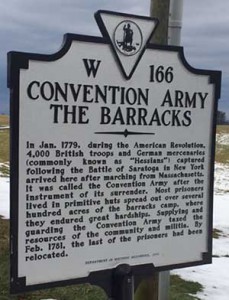Gayle Harvey Real Estate knows the local market, right down to the etymologies of the towns in the Greater Charlottesville area. With a little help from Jean L. Cooper’s A Guide to Historic Charlottesville and Albemarle County, we’ve compiled naming histories for the cities, towns, and unincorporated communities that call central Virginia home. Take a look!
 Barracks
Barracks
As we wrote in this blog, the Barracks area was once a military barracks used to house soldiers during the American Revolution. Thomas Jefferson himself was in charge of the operation, which brought a great deal of revenue from 4,000-odd British and Hessian prisoners. Many of them liked the area so much that they stayed, building homes, lives, and families!
Batesville
The Plank Road area south of Charlottesville leads to Batesville. Originally called Oliver’s Store and then renamed Mount Israel by 1829, the town was finally renamed in honor of the Bates’ an influential family in the area. One source claims that Mr. Bates owned a blacksmith shop. It was settled in the 1730s, making it older than Albemarle itself.
Covesville
This small community is comprised primarily of agricultural farmsteads. It was established in the 1740s by German and Scotch-Irish immigrants seeking religious freedom. A group of Presbyterians founded the town along Rich Cove, a valley in Charlottesville near Cove Creek.

Crozet
Crozet-a census-designated place in Albemarle County-is quickly becoming one of the most popular locations in the Greater Charlottesville area. In 1870, its citizens changed the name of the village from Wayland’s Crossing to Crozet, in honor of Colonel Claudius Crozet. Crozet was a French-born teacher and civil engineer who was instrumental in the construction of the Blue Ridge Tunnel in the 1850s.
Earlysville
Just north of Charlottesville, this small unincorporated community was named for John Early, who settled down with just under 1,000 acres in the general area.
Esmont
Esmont is a small community on rich, fertile land in Albemarle County. When we say small, we mean…less than 600 people. It was named for the Esmont plantation which was an economic driver early in the town’s history.
Free Union
A census-designated place on Albemarle County land, Free Union was originally called Nicksville, after a freed slave named Nick who opened a blacksmith’s shop in the center of town in the 19th century. To avoid confusion with the town of Nixville, the village changed its name to Free Union, after its Free Union Church. The church was “free” because all races could worship there, and it was a “union” of four Christian denominations, none of which could afford a church of their own.
Howardsville
This settlement (originally called Howard’s Landing) was established by planters in the 1730s and 40s, on the northern bank of the James River at the point where it is joined by the Rockfish River. This means that, along with Scottsville, it was one of the founding communities in Albemarle County, predating the foundation of the county itself. The name was changed to Howardsville, but both names are a nod to Allen Howard, one of the original settlement’s principal founders.
Ivy
This crossroad community was probably founded by the Lewis and Woods families in the 1740s along the well-traveled Three Notched Road. That’s Lewis as in Meriwether Lewis, one half of the famous Lewis and Clark expedition. Present-day Ivy was originally called Woodville; then Woodville Depot after the arrival of the railroad in 1851; then Ivy Depot (after Ivy Creek, which flowed through the settlement); and finally Ivy.
Keswick
Keswick was technically “founded” in 1849 when the Virginia Central Railroad connected the cities of Charlottesville and Gordonsville. “Keswick” was the name of the estate that was intersected by the line, a piece of property belonging to the Reverend Thornton Rogers on land that may have been a part of Peter Jefferson’s original Shadwell holdings.


 Barracks
Barracks